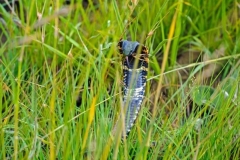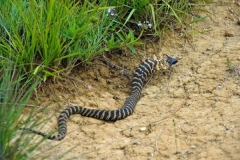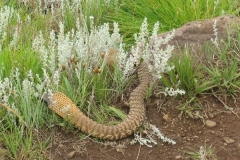Length: 100 – 120 cm average; 150 cm maximum
Description:
In the Natal Drakensberg the rinkhals is banded alternately black and yellow or black and deep orange. The characteristic pale bars or rings across the front of its neck from which it derives its name may be barely visible – these darken with age. It is an athletic looking snake and is capable of a good dash speed when making an escape.
It behaves like typical cobras by rearing when disturbed, forming a broad, flat hood which may extend quite far along its length, but it will maintain this pose for much longer. The back of the hood may be dotted with small yellow or orange rosettes. The rearing movement should draw a hiker’s attention to its presence. This is usually accompanied by loud and prolonged huffing, during which it may choose to spit at any perceived threat – generally the highest point of any object moving nearby. When spitting, the reared part of the body is thrown forward onto the ground to aid the projection of the venom, which is sprayed forwards and upwards from its fangs. If it still feels threatened it may feign death by lying prostrate on the ground, partly belly up with its tongue hanging out.
Biology:
Frogs and rodents form its main diet. On average 20 to 30 live young are produced per brood. They are born late in summer and are about 18 cm long. The young appear to remain in the vicinity of their nest for a while, giving the appearance that the snakes are gregarious and resulting in place names like Rinkhals Bank. Certainly it is common to come across many of these young snakes in a relatively small area, where they give away their presence as their tails disappear down holes in the ground. The young snakes are fully-equipped miniatures of their parents, and just as deadly!
Poisoning Symptoms:
The venom of these front-fanged snakes is partly cytotoxic but also extremely neurotoxic (nerve-destroying), and survival without adequate antivenin during the first 4 to 6 hours is very unlikely. The bite area and affected limb will show some swelling due to the cytotoxic poison, and there will be a tingling sensation due to the neurotoxic poison which may spread further from the bite site as the poison spreads. Early symptoms resemble alcoholic intoxication – impaired vision, drooping eyelids, slurred speech, vertigo and fatigue all occur within 1 to 2 hours. Breathing becomes increasingly difficult and is followed by collapse and coma. Death is due to respiratory failure.
Treatment:
Treat a rinkhals bite as an extreme emergency – in the berg this is a worst-case scenario! This is one bite where the victim should definitely be completely immobilised, and owing to its seriousness he / she will also need a lot of calming! Use a suction kit if you have one (the Aspivenin kit is highly recommended by most snake handlers). APPLY A PRESSURE BANDAGE. Contact a Poison Information Centre and hospitalise the victim as soon as possible. Antivenin should be administered intravenously in large amounts as soon as it is available, but only under medical supervision in case of complications caused by the antivenin itself. Recovery after the injection of antivenin is often remarkable, although the victim should remain under observation in hospital for a few days in case of a recurrence.
Bites from this species are rare and it is more common for the snakes to spit. In this case prompt and thorough flushing of the eyes is essential, and usually no further treatment is needed although the eyes will feel dry and will occasionally smart during the next 24 hours. The victim should also be placed under observation as there is a small possibility that venom may enter the general circulation via the eyes.
Remarks:
The author was told of an incident in which a woman was suddenly confronted by a rinkhals. It appears she may have somehow managed to step on it, which is unusual since the rinkhals is quite capable of out-running danger. It struck at her and then fled. On inspection it appeared that it had not actually bitten her, and after remaining a day under observation at a Poison Treatment Centre in Durban, she was able to go home. Despite the deadly seriousness of a rinkhals bite, this incident serves to confirm that the rinkhals will try to flee, spit or even feign death in preference to biting!
The latest recommendation is to walk out of the Berg and get to a hospital as soon as possible, especially if the weather or darkness will prevent or slow a rescue team from reaching the victim within 4 to 6 hours (*citation needed). The affected limb should be pressure-bandaged and immobilised, the backpacker should be relieved of his / her load to reduce the effort required, and above all else, it is essential that he / she remains calm. It is, after all, reassuring to know that very few people die from snake bite in South Africa.



